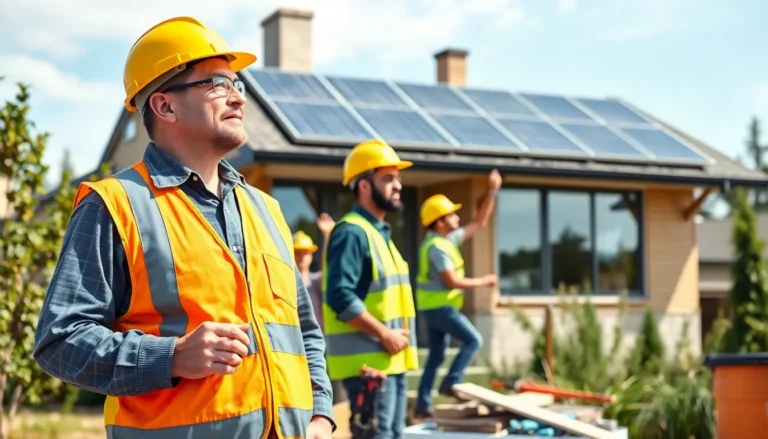Table of Contents
ToggleIn a world that’s buzzing with gadgets and gizmos, the demand for energy storage is skyrocketing. But what if the batteries powering these devices could be as eco-friendly as they are powerful? Enter sustainable battery technology, the superhero of the energy world. It’s not just about saving the planet; it’s about charging into the future with a smile on your face and a green conscience.
Imagine a battery that not only lasts longer but also leaves a lighter footprint on Mother Earth. From electric vehicles to renewable energy storage, sustainable batteries are transforming how we think about energy. They’re the perfect blend of innovation and responsibility, proving that you can have your cake and eat it too—just make sure it’s made from organic ingredients! So buckle up and get ready to explore the electrifying advancements in sustainable battery technology that promise to power a cleaner, greener tomorrow.
Overview of Sustainable Battery Technology
Sustainable battery technology represents a critical advancement in energy storage solutions. This technology utilizes eco-friendly materials and processes, aiming to minimize environmental impact while maintaining high performance levels. Renewable energy sources can efficiently integrate with these batteries, making them ideal for storing energy from solar panels and wind turbines.
Various types of sustainable batteries exist, including lithium-ion, solid-state, and sodium-ion batteries. Lithium-ion batteries, commonly used in electric vehicles, feature improved recycling rates and are shifting towards sustainable sourcing processes for raw materials. Solid-state batteries enhance safety and energy density while reducing risks associated with flammable components.
Another promising option, sodium-ion batteries, leverage abundant sodium resources, presenting a lower-cost alternative. Their development focuses on achieving competitive performance compared to traditional options. These new solutions not only aim for higher safety standards but also strive to address ethical sourcing concerns.
Manufacturers increasingly prioritize sustainability in their production methods. Companies are developing eco-design principles to ensure batteries remain recyclable at their end of life. Efforts to close the loop on battery materials add significant value, reducing waste and promoting circular economy practices.
Innovative research is ongoing in this field, focusing on next-generation battery chemistries that improve efficiency. Enhancements in energy density and charging speeds affect various sectors, from consumer electronics to large-scale energy systems. Investing in sustainable battery technologies can directly support the transition toward greener energy landscapes.
Importance of Sustainable Battery Technology

Sustainable battery technology plays a crucial role in addressing energy demands. Its impact extends to environmental and economic aspects.
Environmental Impact
Sustainable batteries significantly reduce pollutants throughout their lifecycle. They incorporate eco-friendly materials that diminish reliance on harmful mining practices. The recycling potential for these batteries enhances resource management, conserving valuable raw materials. Lower emissions during production processes contribute to a cleaner atmosphere. Innovations like solid-state and sodium-ion batteries further minimize ecological footprints. Notably, these technologies support renewable energy integration, facilitating seamless energy storage for solar and wind applications.
Economic Benefits
Investing in sustainable battery technology offers considerable economic advantages. Cost reductions arise from improved manufacturing processes and increased efficiency. Enhanced battery lifespan results in fewer replacements, lowering overall expenses for consumers and industries. As demand for electric vehicles grows, jobs in sustainable battery production and recycling increase. Innovations drive new markets, contributing to economic growth and stability. Reducing dependence on traditional fossil fuel sources allows for greater energy independence and security, benefiting national economies.
Types of Sustainable Battery Technologies
Sustainable battery technologies encompass various innovative types that emphasize environmental responsibility while providing efficient energy solutions. Each type presents distinct advantages.
Lithium-Ion Alternatives
Lithium-ion alternatives include batteries like sodium-ion and lithium-sulfur. Sodium-ion batteries utilize abundant raw materials, ensuring supply chain sustainability. Lithium-sulfur batteries offer higher energy density, supporting longer usage times between charges. Both options enhance recycling rates, further contributing to an eco-friendly approach. Manufacturers focus on these alternatives to reduce reliance on traditional lithium sources, which face environmental extraction challenges.
Solid-State Batteries
Solid-state batteries represent a significant advancement in battery technology. These batteries replace liquid electrolytes with solid materials, improving safety by minimizing fire risk. Enhanced energy density leads to longer battery life, making solid-state options particularly attractive for electric vehicles. Researchers anticipate that this technology will enhance charging speeds, allowing devices to power up faster. With strong promises for the future, solid-state batteries could redefine energy storage paradigms.
Flow Batteries
Flow batteries offer a unique approach to energy storage, using liquid electrolytes stored in external tanks. This design enables scalability, allowing larger systems for grid storage or renewable energy integration. High cycle life and low degradation rates ensure longevity and reliability, making them suitable for stationary applications. Environmental impact is reduced since many flow battery types utilize non-toxic materials. As renewable energy adoption increases, flow batteries play a crucial role in stabilizing energy supplies.
Innovations in Sustainable Battery Technology
Innovative approaches in sustainable battery technology focus on enhancing performance while minimizing ecological footprints. This area includes advancements in recycling and the use of alternative materials.
Recycling and Repurposing
Recycling plays a crucial role in sustainable battery technology, boosting resource efficiency. Closed-loop systems allow for the recovery of valuable materials like lithium and cobalt, significantly reducing the need for virgin resources. Up to 95% of battery components can be recycled through these advanced processes. Repurposing involves giving old batteries a second life, specifically in energy storage applications. For example, retired electric vehicle batteries often serve as grid storage, meeting energy demands during peak usage. Implementing rigorous recycling protocols minimizes environmental impact and fosters a circular economy in battery production.
Alternative Materials
Alternative materials drive innovations in sustainable battery technology. Sodium-ion batteries utilize abundant sodium resources, presenting a lower-cost option compared to traditional lithium-ion batteries. These batteries show promise with competitive energy densities and improved safety profiles. Moreover, lithium-sulfur batteries offer higher capacity due to their lightweight and non-toxic components. Researchers explore organic materials, like lignin, to reduce reliance on finite resources. The use of eco-friendly materials not only mitigates environmental concerns but also aligns battery production with sustainability goals, enhancing overall performance.
Challenges Facing Sustainable Battery Technology
Sustainable battery technology faces several significant challenges. Resource availability presents a critical issue, particularly for materials such as lithium and cobalt. These materials often come from regions with ethical and environmental concerns tied to mining practices.
Recycling processes require further development to optimize resource recovery and efficiency. While advancements exist, achieving high recovery rates for all battery components remains a challenge in many regions.
Cost competitiveness also impacts the adoption of sustainable batteries. Companies often encounter higher production costs for eco-friendly alternatives, which can deter investment compared to traditional options. In some cases, the market’s price sensitivity hampers the growth of sustainable alternatives.
Performance limitations emerge with alternative technologies such as sodium-ion and lithium-sulfur batteries. These types often struggle to match the energy density and efficiency of established lithium-ion batteries. Researchers are working to overcome these performance gaps to enhance viability in mainstream applications.
Safety and reliability issues can impede the wide-scale implementation of new battery technologies. Solid-state batteries, while safer than liquid electrolyte counterparts, still face challenges in scaling production and maintaining performance over time.
Regulatory frameworks also play a crucial role in shaping the sustainable battery landscape. Inconsistent regulations across different regions can hinder companies’ ability to innovate and invest in sustainable technologies. A standardized approach could streamline processes and encourage broader adoption.
Lastly, consumer awareness and understanding of sustainable technology remain limited. Educating the public on the benefits and potential of sustainable batteries is essential for driving demand and fostering acceptance. Increased awareness can motivate manufacturers to prioritize sustainability in development and production practices.
Future of Sustainable Battery Technology
Sustainable battery technology continues to evolve rapidly, promising significant advancements in energy storage solutions. Innovations in lithium-ion alternatives, such as sodium-ion and lithium-sulfur batteries, emphasize the use of abundant materials that enhance energy density. Increased focus on solid-state batteries contributes to improved safety and energy density, making them a preferred choice for electric vehicles.
Researchers prioritize recycling as a key element in sustainable technologies. Closed-loop systems now recover up to 95% of battery components, significantly reducing the demand for new resources. Repurposing retired electric vehicle batteries for grid storage addresses energy demands while extending the lifecycle of these batteries.
Challenges persist in sustainable battery technology. Resource availability remains critical, with sourcing issues related to lithium and cobalt complicating production. Inconsistent recycling processes hinder resource recovery, while alternative technologies struggle to match the efficiency of traditional lithium-ion batteries. Safety concerns surrounding new technologies require thorough evaluation to ensure reliability.
Environmental impact remains a priority. Advancements in eco-design principles and circular economy practices promote responsible manufacturing and minimize ecological footprints. Education plays a vital role in raising consumer awareness, driving acceptance of sustainable technology.
The future seems promising for sustainable battery technology. Ongoing research and innovations will likely contribute to energy independence and economic stability, while fostering a cleaner, greener future.
Sustainable battery technology stands at the forefront of the energy revolution. As innovations continue to emerge the potential for a cleaner and more efficient energy landscape grows. These advancements not only promise enhanced performance but also prioritize environmental responsibility.
The shift towards eco-friendly materials and improved recycling methods is crucial for reducing ecological footprints. With ongoing research and development the industry is poised to overcome existing challenges and drive significant progress.
Embracing sustainable battery solutions will not only meet the rising energy demands but also foster economic growth and energy independence. The future looks bright as society moves towards a greener and more sustainable energy future.







